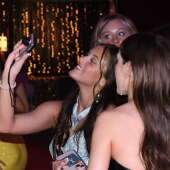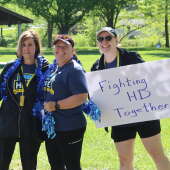"This Can Be Art"

Catapult Creative House constructs workstations for computer science students
An online program that teaches coding languages like Java and Python to high school students in developing countries, in their native languages.
This is what senior Southeast Missouri State University students and tech start-up team members Faizel Khan, Chandrashekhar Singh, Arham Chowdhury and Prathyush Viswaroopan have been working on developing over the past six months. And they’re using the spaces at Catapult Creative House — complete with new computer science-specific workstations — to create it.
Launched in March 2018, the goal of the new workstations is to attract computer science students to Catapult, providing a place for them to work and collaborate with the Southeast student artists and entrepreneurs who also utilize the building.
The new space includes four computer workstations with printer access. The computers are imaged with approximately 30 software programs, including all of the software available on the computer science-specific computers at Southeast’s main campus, plus programs computer science students requested in order to meet their additional programming needs. In addition to state-of-the-art software, computer science students have 24/7 access to the building, workstations, professors, and art and business students who spend time in the building. Plus coffee.
These workstations were funded in their entirety — including equipment, printing and the March launch event seminar featuring Microsoft’s Chad Lich and Alex Zisser — by the Southeast Missouri State University Harrison College of Business, under the leadership of Dr. Judy Wiles.
The interrelatedness of the sciences and humanities — which is at the heart of Catapult’s mission — is something Khan, Singh, Chowdhury and Viswaroopan understand well and want to promote through their tech start-up.
“If students have a hard time understanding basic math concepts, they can be really good computers, but they cannot be artists,” says Chowdhury. “Some of the greatest work that has been done in the past century in the sciences has actually been leaps in intellect. Einstein did his Gedankenexperiments — his thought experiments — and that was not something that you teach, you know? It’s art. So we want to show that math and science and computer science, these are not just hardcore science-y things, this can be art.”
In today’s environment, computer science can be used by any discipline, ranging from art, linguistics, music, psychology to business, chemistry, engineering and math, to name a few, explains Dr. Sumanth Yenduri, professor and chairperson of Southeast’s computer science department.
“In today’s world to do business — mobile apps, web applications, whatever you want to do — you need computer science,” says Dr. Yenduri. “Our [computer science] students are brilliant with ideas; what they lack is getting the help in taking their ideas and building upon them to develop into a big organization. We would like our computer science students who work at Catapult to get the business expertise of the entrepreneurship professors and students. Then maybe the next Google comes out of there.”
Dr. Yenduri estimates there are currently more than 15 computer science students utilizing the space at Catapult; at the beginning of the school year, before the incorporation of the new workstations, there were zero.
“You don’t know if a computer science student is going to work with an art student and come up with something you’ve never imagined because of their way of doing something, combined with the art student’s idea about how that could be put together,” says Dr. Yenduri.
With the advent of the computer science workstations at Catapult, students now have a place for these opportunities.
The Start-Up

Khan, Singh, Chowdhury and Viswaroopan all tutor high school and college students, and are passionate about education. They cite their own experiences with education as the catalyst for their start-up.
“My elder brother, he’s a principal of a government school in my country,” says Khan, who is from India and a studying computer science at Southeast. “I went to his school and I saw that there are many students who are very talented, but they don’t have good resources, they don’t know anything about this. So that’s why we decided to create these types of resources, so we can provide these types of resources that will help the students.”
Chowdhury’s belief in the start-up comes from his own high school experience.
“I got internet in my home when I was in the eleventh grade, and at that point, a whole new doorway came open to me,” says Chowdhury, who is from Bangladesh and studying math and physics at Southeast. “I was passionate about physics and astrophysics all my life, but I’d never actually experienced anything. So I went online and tried to look up video lectures, and I found this amazing website called MIT OpenCourseWare, where it had amazing video courses from MIT, and I was fascinated. I watched the entire series of three courses and then that brought me to Khan Academy, where I learned a new, intuitive way to learn math. Those jumping points made me realize that we’ve been missing out on so much, and there’s a lot of people who have been missing out on so much.”
The missing link, the team members found, was a lack of command of the English language.
“The students are keen to learn, they have internet, but they don’t know English very well, and that’s why they cannot access all the tutorials that are there on the internet in English,” says Khan. “That’s why we are focusing on local languages. Since they have internet, they can go on the portal platform we are making and teach themselves.”
The team would like to eventually expand their program to all disciplines, for all students — from rural India to inner-city Chicago. The world opened up for teenagers from all backgrounds.
And the ideas are being born at Catapult Creative House in Cape Girardeau.
“For me, I think this space is very open, energetic — it brings out creativity,” Chowdhury says of Catapult. “When we are in our apartments, it’s like, okay, four guys in an apartment — it’s all jumbled up. When we are here, we feel like, okay, this is a very artsy place, and we feel very imaginative and very positive.”


































